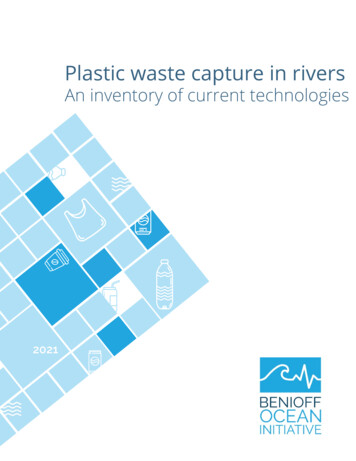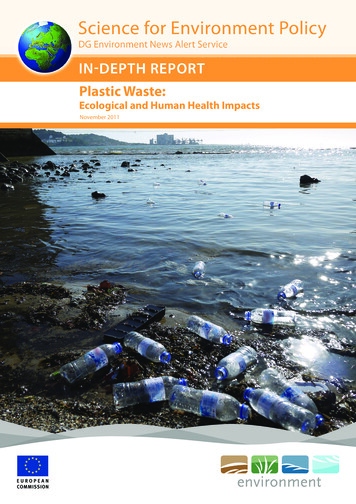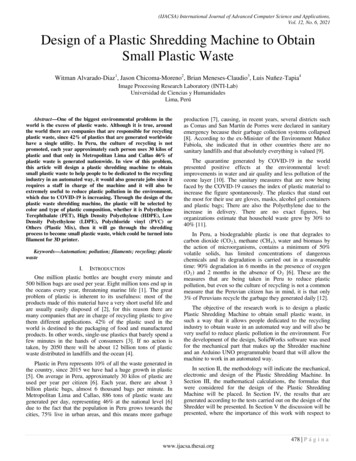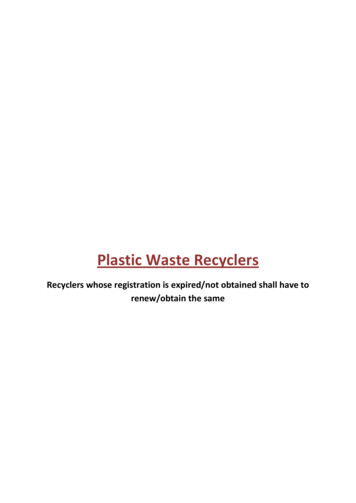
Transcription
Plastic waste capture in riversAn inventory of current technologies2021
The Benioff Ocean Initiative, based in the Marine Science Instituteat the University of California, Santa Barbara (UCSB) works toleverage science and technology to solve ocean problems andinspire the replication of these successes. The Initiative wasfounded in 2016 by a gift to UCSB from Marc and Lynne Benioff.Learn more at boi.ucsb.edu.The Clean Currents Coalition is one of Benioff Ocean Initiative’sflagship programs. The Coalition is a network of teams pilotingdifferent approaches to capturing plastic waste in river systemsaround the world to address one of the leading sources of plasticwaste transport into the oceans. Several of the technologiesfeatured in this document are being tested by Coalition memberprojects. Learn more at cleancurrentscoalition.org.AuthorsJuan Silva, Molly Morse, and Valeria Tamayo-CañadasReport designTia KordellRecommended CitationBenioff Ocean Initiative. 2021. Plastic waste capture in rivers: Aninventory of current technologies.AcknowledgementsThe authors would like to thank the members of the CleanCurrents Coalition for their tireless work to give the world cleanerrivers and oceans. We would like to acknowledge the otherorganizations and individuals that contributed information tomake this report possible. We thank the Benioff family and TheCoca-Cola Foundation for their financial support of the BenioffOcean Initiative and Clean Currents Coalition that makes this workpossible.ContactFor any questions about this paper, contact the Benioff OceanInitiative: boi-contact@ucsb.eduNote about unitsWe use the metric system to report measurements, and theUnited States dollar (USD, ) to report currency.DisclaimerThe Benioff Ocean Initiative does not necessarily endorse any ofthe specific products or companies included in this report, andacknowledges that this inventory is not exhaustive of all potentialriver plastic capture technologiesBENIOFF OCEAN INITIATIVE / PAGE A
Ta b l e o fContentsExecutive Summary1Introduction38Technology profilesBoomsFences, screens and barriersRotating modulesTrapsTrash WheelInterceptorBubble BarrierSkimmer vesselsUnmanned skimmersPumps and vacuumsTrash trawlsOther urban solutions81216202427303337414548BENIOFF OCEAN INITIATIVE / PAGE B
ExecutiveSummaryRivers serve as a major conduit of pollution, includingplastic waste, into the oceans. An estimated 19 to 23million metric tons (Mt) of plastic waste enter aquaticecosystems (rivers, lakes, and oceans) every year, withbetween 0.8 and 2.7 Mt entering the oceans fromrivers. The key role that rivers play in carrying wasteAn estimated 19 to 23million metric tons (Mt) ofplastic waste enter aquaticecosystems (rivers, lakes, andoceans) every year.from land to sea provides a strategic opportunity toturn off the tap of plastic waste into the oceans.This paper offers an inventory of several prominentriver plastic waste collection technologies operatingin different river systems around the world. Theserange from passive devices such as booms, traps,and barriers that rely on river currents to concentratedebris, to integrated powered systems that activelycapture or concentrate debris at high-volume sites,such as the Trash Wheel, the Bubble Barrier, andskimmer vessels. Several factors are consideredin each technology profile, including ons,maintenance requirements), cost, impact on theenvironment, and examples of applications. Theinformation presented in this paper came fromBenioff Ocean Initiative’s experience leading the CleanCurrents Coalition, a global network of organizationsPortoviejo River, Ecuador. Credit: Ichthion LtdBENIOFF OCEAN INITIATIVE / PAGE 1
Left to right: Trash trap in Lat Phrao Canal, Thailand. Credit: TerraCycle Global Foundation; Nairobi River cleanup, Kenya.Credit: Chemolex Company Ltdpiloting different technologies for capturingplastic waste in rivers; direct correspondence withtechnology developers; and internet research. Asthe Clean Currents Coalition program is ongoingand as we continue to learn more about strategiesfor capturing and preventing plastic waste in riversand the oceans, we hope to continue to share morelessons learned.The goal of this paper is to deliver an instructiveand actionable tool to practitioners who wish touse technology to join the great global challenge ofcleaning plastic waste from our rivers, and ultimatelyoceans. The authors recognize that capturingand cleaning up plastic waste is only one piece ofa comprehensive strategy needed to prevent itsleakage into the oceans, and wholeheartedly supportefforts also aimed at policy change, reduction ofproduction, consumer education and behaviorchange, and improved waste management capacityand technology.The goal of this paper isto deliver an instructiveand actionable tool topractitioners who wish to usetechnology to join the greatglobal challenge of cleaningplastic waste from our rivers,and ultimately oceans.ReferencesBorelle et al. 2020. Predicted growth in plastic waste exceeds efforts to mitigate plastic pollution. Science 369:1515-1518.Meijer et al. 2021. More than 1000 rivers account for 80% of global riverine plastic emissions into the ocean.Science Advances 7: eaaz5803.BENIOFF OCEAN INITIATIVE / PAGE 2
IntroductionThe ProblemThe OpportunityRivers are the arteries of the planet. Like the bloodvessels that deliver oxygen-rich blood throughoutour bodies, rivers carry water and critical nutrientsthrough terrestrial and aquatic ecosystems andinto lakes and oceans. They shape and transformlandscapes and promote life by offering innumerableecosystem services such as drinking water for humansand animals; irrigation for agriculture; and recreation,cultural, and ceremonial sites.The key role that rivers play in carrying waste fromland to the oceans provides a strategic opportunityto turn off the tap of plastic waste into the oceans.In the oceans, plastics break down into smaller andsmaller pieces (microplastics), and are transported bymixing and currents throughout the water column allthe way to the deepest depths, making the possibilityof capture extremely difficult to impossible. On theother hand, rivers are shallower and more contained,allowing for easier access to the debris they carry,and are relatively more controlled environments thanthe oceans, allowing for safer operating conditions.But apart from transporting life-giving elements andproviding invaluable ecosystem services, rivers alsoserve as a major conduit of pollution. An estimated19 to 23 million metric tons (Mt) of plastic waste enteraquatic ecosystems (rivers, lakes, and oceans) everyyear. Of that total, 4.8 to 12.7 Mt of plastic waste flowinto the oceans specifically, and 0.8 to 2.7 Mt of thatis transported by rivers.Thanks to these advantages, technological systemsthat capture plastic waste in rivers are being deployedaround the world. These systems generally seekto accomplish the same goal: to concentrate andcapture plastic and other debris in rivers so it can beremoved and properly disposed of. They range fromThe key role that rivers playin carrying waste from land tothe oceans provides a strategicopportunity to turn off thetap of plastic waste into theoceans.The Bubble Barrier in Westerdok Canal, Amsterdam.Credit: The Great Bubble BarrierBENIOFF OCEAN INITIATIVE / PAGE 3
simple, low-cost booms, barriers, and nets that aremanually operated and maintained and passively relyon the river’s current to concentrate the debris; tohigh-tech, high-investment electricity, hydrokinetic orsolar-powered concentrators and conveyors. Today,these systems are designed, constructed, deployed,operated, and financed by a variety of entitiesworldwide, such as nonprofit organizations, techstart-ups, and governments.The Clean Currents Coalition is a network of teamsoperating in countries around the world to combatthe flow of plastic waste from rivers to oceans.Supported by the Benioff Ocean Initiative at theUniversity of California, Santa Barbara and The CocaCola Foundation, the Coalition is piloting innovativenew technologies and reimagining pre-existing onesto capture plastic waste from polluted river systemsaround the world: Tijuana River in Mexico, JuanDiaz River in Panama, Portoviejo River in Ecuador,Kingston Harbour in Jamaica, Athi-Galana-SabakiRiver in Kenya, Lat Phrao Canal in Thailand, Red Riverin Vietnam, and Citarum River in Indonesia. In additionto deploying these plastic capture technologies, theClean Currents Coalition is collecting and using datato implement outreach and education campaigns toempower changes in human behavior, policy, andinfrastructure to reduce the production and use ofsingle-use plastics and improve waste managementsystems.It is important to acknowledge this importantpoint: the problem of plastic pollution is extremelycomplex. Cleaning up plastic in rivers specifically,and in the environment generally, is only one pieceof a much more holistic set of solutions needed ifwe are to address this challenge globally. Tools thatprevent plastics from entering waterways, such asstormwater filters, and those that capture plasticsalready in the oceans, such as The Ocean Cleanup’sSystem 001, are important for capturing plasticwaste along its entire aquatic journey. At a broaderscale, we also need the development of systemicpolicy changes to curb plastic pollution (includingimproved waste management and producerresponsibility); replacement of single-use plasticswith cost-effective, functional alternatives; changesin personal and population-level use behaviors thatreduce plastic demand; and improvements in plasticwaste management and recycling. Only by combiningthe reduction of plastic production, improvement ofwaste management, and recovery of plastic wastefrom the environment can we drastically reduce totalplastic emissions into the environment.Cleaning up plastic in riversspecifically, and in theenvironment generally, isonly one piece of a muchmore holistic set of solutionsneeded if we are to addressthis challenge globally.Nairobi River, Kenya. Credit: Chemolex Company LtdBENIOFF OCEAN INITIATIVE / PAGE 4
This document is a product ofthe Benioff Ocean Initiative’swork through the CleanCurrents Coalition to fulfilla need for a compilation ofthe different plastic capturetechnologies that can beadapted to the diverse riversystems and water bodies.Paper OverviewLat Phrao Canal trash trap, Thailand.Credit: TerraCycle Global FoundationTijuana River, MexicoCredit: WILDCOASTThe Clean Currents Coalition was conceived underthe assumption that the only way to solve the globalplastic problem is collaborative action and scalablesolutions. Therefore, part of the Benioff OceanInitiative’s mission is to provide the public with theknowledge and lessons learned from experiencewith the experts and practitioners designing andimplementing solutions to divert plastic waste fromrivers. This document is a product of the BenioffOcean Initiative’s work through the Clean CurrentsCoalition to fulfill a need for a compilation of thedifferent plastic capture technologies that can beadapted to the diverse river systems and waterbodies. As the Clean Currents Coalition program isongoing, we hope to continue to share more lessonslearned over the course of the next few years.The goal of this document is to deliver an instructiveand actionable guide to practitioners who wishto join the great challenge of cleaning our rivers,and ultimately oceans, from plastic waste. Thisdocument focuses exclusively on river interventiontechnologies. For a larger, broader inventory oftools that can be implemented anywhere fromhouseholds and urban waterways to rivers andoceans, visit the Plastic Pollution Prevention andCollection Technology Inventory from the NicholasInstitute for Environmental Policy Solutions atDuke University ology-inventory).BENIOFF OCEAN INITIATIVE / PAGE 5
Because of the large disparity in river characteristics,such as depth, width, discharge, flow rate, seasonality,climate, pollution load, etc., effective technologieshave to be adapted to these conditions. Thereis no one-size-fits-all solution. We profile severaldifferent categories of technologies, as well as someOverview1unique patented technologies, with the hope thatpractitioners will find the one that best fits theirparticular environmental and social conditions, aswell as their budgets. Each profile is structured in thefollowing way:Energy SourceDimensionsBrief description of thetechnology’s structure andfunctionHow the technology is powered, ifat all (e.g., solar, fuel, passive)Approximate size andconfigurationSuitable ConditionsCostMaintenanceTypes of environments andhydrological conditions to whichthe technology is known oranticipated to be best suitedApproximate example estimatesof design, construction, and/oroperation costs -- as available andfor reference only1Known or anticipated maintenancerequirementsEnvironmental ImpactsStrengths & WeaknessesApplicationsKnown or anticipatedenvironmental impacts(physical and/or biological)Comparative notable advantagesand disadvantagesReal-world instances of technologytesting or deploymentPlease note that costs may change and should be obtained directly from the product manufacturer or dealer.BENIOFF OCEAN INITIATIVE / PAGE 6
Although the technological aspects of solving theplastic waste problem in rivers are key, there areseveral other important considerations of anypotential intervention that are not covered in thisdocument. First, although cleaning up plastic wastein rivers is critical to restoring ecosystem health,it is important to acknowledge and mitigate thepotential for bycatch and habitat impacts duringtechnology deployment. As these technologies areincreasingly tested and deployed in the coming years,practitioners should monitor and evaluate impacts onorganisms they may interact with. Important also toconsider are stakeholder engagement and support(local governments, businesses, and communities),existing policies and regulations (including permitting),required infrastructure to properly manage capturedwaste, and added-value business plans. Each particularcontext will require a tailored approach that considersthese factors in order to successfully implement aplastic capture strategy in rivers.Matias Hernandez River, Panama. Credit: Marea VerdeCitarum River, Indonesia. Credit: Greeneration FoundationReferencesBenioff Ocean Initiative. 2019. River Plastic Pollution: Considerations for addressing the leading source ofmarine debris. Accessible at boi.ucsb.edu.Borelle et al. 2020. Predicted growth in plastic waste exceeds efforts to mitigate plastic pollution. Science 369:1515-1518.Falk-Andersson et al. 2020. Basic principles for development and implementation of plastic clean-uptechnologies: What can we learn from fisheries management? Science of the Total Environment 745: 141117.Jambeck et al. 2015. Plastic waste inputs from land into the ocean. Science 347: 768–771.Meijer et al. 2021. More than 1000 rivers account for 80% of global riverine plastic emissions into the ocean.Science Advances 7: eaaz5803.Schmaltz et al. 2020. Plastic pollution solutions: emerging technologies to prevent and collect marine plasticpollution. Environment International 144: 106067.BENIOFF OCEAN INITIATIVE / PAGE 7
BOOMSOverviewBooms are widely used to capture floating plastic and other debris in waterways. Booms useflotation structures, often with curtains suspended into the top of the water column, designed tocapture buoyant materials. Booms can also be designed to absorb oils and grease. They are typicallyanchored to the shoreline and the riverbed downstream of one or more trash outfalls. The size of a boomcan easily be customized based upon the size of the river and the expected volume of floating debris thatcan be carried by the river system. Material captured in a boom can be removed manually, with an excavator,conveyor, or a skimmer vessel.Booms can be a component of other more complex waste capture systems, such as traps and trawlers. There isalso the so-called “Biofence” that mimics the structure of a boom using upcycled bottles for flotation. Biofencesare generally constructed of PET beverage bottles and netting.The “Barrera o basura” (“B.o.B.”) that was operated in the Matías Hernández River in Panama. Credit: Marea VerdeBENIOFF OCEAN INITIATIVE / PAGE 8
Booms in the Assi River in Varanasi,IN.Credit: Renew OceansEnergy SourcePassive (no energy source required)MaintenanceProper anchoring is very important and should havea geotechnical engineer’s assistance, and pilingsor ground anchors should be used to secure thesystem. These should be inspected and maintainedregularly. Continual manual collection of debris is alsoimportant, but highly labor intensive; boats, cranes, orconveyors might be used.Suitable ConditionsBooms represent a good option in smaller rivers orcanals with relatively weak currents, especially wheremaintaining vessel navigability is not required and aboom can extend from one bank to the other. In thecase of waterways that are utilized by small vesselsor kayaks, the booms can be equipped with a flexiblemodule that will allow them to pass above the booms.Biofences do well in smaller rivers because they arelightweight and have low durability. Their ability tocapture trash is maximized when spread across thewidth of a waterway.DimensionsVariable. Can come in a variety of sizes depending onthe waterway, from small booms measuring 1m widex 4m long to large booms measuring 4m wide x 15mlong or more.CostCosts will vary, but this is generally a low-cost option.For example, the Black Brute Boom made by Elastecranges from USD 697 per 3m to 1,052 per 6.1msections, and the optional 0.6m debris screen rangesfrom USD 275 per 3m to USD 507 per 6m section.Costs for Biofences made from upcycled materialsare generally much lower.Environmental ImpactsIf the boom is not properly maintained and emptiedregularly, the build-up of debris could have a negativeimpact on aquatic life. Submerged mesh nettingextending below the boom may entangle fish, althoughit will vary according to net material (aluminum meshnetting better allows wildlife to flow underneath).Smaller organisms may also be affected but larger fishshould be able to swim beneath.BENIOFF OCEAN INITIATIVE / PAGE 9
Strengths Floating anchored system allows traps to riseand fall with changing water levels due to seasonalchanges, rain, wind, and irregular current and flowrates Effective in capturing various types of floatingdebris at or near the surface without endangeringor obstructing aquatic life Adaptable and modular, so it can easily be modifiedto suit different size waterways and waste volumesWeaknesses In most cases, trash must be removed from thetrap manually Does not extend deep into the water column tocollect suspended litter May not capture debris across the entire width ofthe waterway Capture rates may be low when water levels orwater movement are low Can be locally constructed by metal fabricatorsworldwide, and so it can also be easily repaired oradapted for customized use Offers flexibility and mobility to avoid interferencewith residential/commercial boat trafficElastec Brute Boom with debris screenin Los Laureles Canyon, tributary of theTijuana River, MX.Credit: WILDCOASTBENIOFF OCEAN INITIATIVE / PAGE 10
ApplicationsWILDCOAST installed an Elastec Brute Boom at Los Laureles Canyon, Tijuana, Mexico. The boom consists of8 HDPE floaters of 40 cm diameter and stuffed with expanded polystyrene. Each floater has a galvanized steelscreen. The barrier is attached to concrete structures on the banks of the river through galvanized chains andgalvanized steel shackles.Marea Verde operated the “B.o.B” (Barrera o basura, translation: Barrier or garbage) on the Matías HernándezRiver, Panamá. The B.o.B. was originally just a boom, but was later reinforced with fencing to prevent debrisspilling over or under the boom.The Litterboom Project is installing large pipes in South Africa anchored across the rivers, which acts as acatchment for all surface-level plastics.Plastic Fischer is installing its booms in rivers in Indonesia, India, and Vietnam, where the devices are wellsuited to wide areas with low flow speeds.The country of Guatemala installed 2 bio-fences in the Motagua River.AlphaMERS has installed floating barricades that carry debris to the riverbank for manual or mechanicalcollection across cities in India.ReferencesTrash Capture Technologies. US EPA. Accessed on 4 November 2020 at e-technologiesStandard floating barriers. Sea Defence Solutions. Accessed 4 November 2020 at rd-floating-barriers/Tijuana River, Mexico. Clean Currents Coalition. Accessed 22 April 2021 at on-projects/tijuana-river-mexico/B.o.B. Litter Trap. Marea Verde. Accessed 22 April 2021 at https://en.mareaverdepanama.org/projecto-5The Litterboom Project. Accessed 22 April 2021 at https://www.thelitterboomproject.com/Plastic Fischer. Accessed 22 April 2021 at https://plasticfischer.com/Sanchez, Erica and Maes, Sophie. 2018. Guatemala is using “bio-fences” to curb plastic pollution. GlobalCitizen -plastic-pollution-bio-fences/Floating Trash Barrier. AlphaMERS. Accessed 20 November 2020 at loating-trash-barrierBENIOFF OCEAN INITIATIVE / PAGE 11
F E N C ES ,SCREENS &BA R R I E R SOverviewThis category comprises solutions based on the installation of fences, screens, or barriers that trapplastic and other waste. These have similar characteristics to booms but differ structurally and can beconstructed of various materials, such as chain-link fencing, reinforcing bar (“rebar”), or plastic mesh net.Blue Barriers by Sea Defence Solutions (SEADS) are designed to divert floating waste towards the riverbank. Credit: SEADSBENIOFF OCEAN INITIATIVE / PAGE 12
The Azure system by Ichthion Ltd will usea barrier and a conveyor belt to captureplastics in rivers. The first device is beingdeployed in the Portoviejo River, Ecuador.Credit: Ichthion LtdEnergy SourcePassive (no energy source required)MaintenanceIf debris accumulates along the fence or barrier, itmust be manually emptied frequently enough toprevent a blockage.DimensionsFully adaptable to river location.CostA basic fence may cost a few thousand USD. TheNash Run Trash Trap near Washington, DC, USA cost 2,000 for the initial build and an additional 2,700for repairs, modifications, and maintenance.Sea Defence Solutions’ Blue Barriers have the followingcost structure: 50 m wide river - 166,000; 100 m wideriver - 309,000; 200 m wide river - 605,000.Suitable ConditionsShould be installed in rivers with flow rates that aresufficiently low such that they do not pose a threat todismantling the structure.Environmental ImpactsA fence or screen that extends from the river surfaceto the bottom of the riverbed may prevent movementof larger aquatic organisms. Sea Defence Solutions’Blue Barriers are designed such that fish will be ableto continue their transit beneath and between thebarriers.BENIOFF OCEAN INITIATIVE / PAGE 13
Strengths Modular barrier structures can be configuredto allow vessels to pass through with only a slightvariation in direction Structures can capture debris across the entirewidth of the river Fences and screens can be low costWeaknesses Some fence structures do not allow for the passageof vessels or especially large debris The size of debris captured is dependent upon themesh size of the fence or screen material Blockages may cause flooding of the surroundingriverbankThe Nash Run TrashTrap was installed inthe Anacostia Rivernear Washington, DC,USA in 2009.BENIOFF OCEAN INITIATIVE / PAGE 14
Chemolex Company Ltd has installed five fences in the Nairobi and Ngong Rivers, Kenya. Waste is removed with a mechanicalconveyor. Credit: Chemolex Company LtdApplicationsThe Nash Run Trash Trap was installed in the Anacostia River near Washington, DC, USA, and was 100%effective at capturing plastic beverage bottles, take-out food packaging, and bags.Sea Defence Solutions’ (SEADS) Blue Barriers are expected to collect 100% of suspended waste under idealconditions.Chemolex Company Ltd has installed fences at several locations on the Nairobi and Ngong Rivers in Kenya.Plastic and other debris are removed from the fence by a mechanical electricity-powered conveyor.The Azure system by Ichthion is an enhanced barrier designed for preventing river plastic waste from reachingmarine environments. As of May 2021, it is being deployed in the Portoviejo River, Ecuador.ReferencesAthi River, Kenya. Clean Currents Coalition. Accessed 21 April 2021 at cts/athi-river-kenya/Blue barriers. Sea Defence Solutions. Accessed 20 November 2020 at Maeda, Masaya. Demonstration of Trash Reduction Technologies in the Anacostia Watershed (Nash Run TrashTrap Project). Anacostia Watershed Society. 2010. Accessible at ddoe/publication/attachments/Nash Run TT Final Tech Report Entire.pdfPortoviejo River, Ecuador. Clean Currents Coalition. Accessed 21 April 2021 at cts/portoviejo-river-ecuador/BENIOFF OCEAN INITIATIVE / PAGE 15
R OTAT I N GM O D U L ESOverviewThis category comprises technologies that use rotating concentration modules to divert the riverwaste to a collection site. We identified two primary technologies in this category:The River Cleaner created by RiverRecycle consists of active concentration modules placed along the riverto guide the plastic and other waste to one side, followed by an automatic collection wheel that lifts the wasteout of the river. The system is designed to capture 20-100t of waste per day, and collect all waste larger than1.5cm floating within 1m depth.The River Cleaning System, created by River Cleaning, is a series of rotating modules positioned diagonally onthe course of the river that intercepts plastic waste and transports it to a storage and extraction area at theriver bank.The River Cleaner by RiverRecycle at the testing facility. Credit: RiverRecycleBENIOFF OCEAN INITIATIVE / PAGE 16
The River CleaningSystem by River Cleaningis a series of floatingdevices, positioneddiagonally on the courseof the river, that interceptand transport plasticwaste to the river bank.Credit: River CleaningEnergy SourceThe river current rotates the concentrator modules.Other power sources may be required for the wasteextraction.MaintenanceThe systems are designed to be modular so anydamage is limited to individual units that can be easilyrepaired or replaced. Debris will need to be removedmanually or automatically from the collection sitealong the river bank.Suitable ConditionsRequires a current to rotate the modules. Themodular design can be implemented to ensure thatthe river stays navigable at sites with both aquatic lifeand vessels.DimensionsThe modular design allows for adjustability to riversize and conditions.CostConstruction costs of the River Cleaner are estimatedat 120,000, with operating costs of 22,000 per year.Environmental ImpactsThe River Cleaning System claims to allow fish to swimpast the modules and proposes to use a device thatwill deter fish from entering the extraction area.BENIOFF OCEAN INITIATIVE / PAGE 17
StrengthsWeaknesses Continuous autonomous operation Does not collect submerged debris Modular and scalable to meet the requirementsof each location Relies on a relatively strong and consistent currentto operate Relatively easy to install and dismantle to anticipatedrastic changes in river volume Concentrators ensure a constant flow of wasteand avoid accumulation Low risk of breaking or being submerged by heavycurrents relative to rigid barriers Malfunctions are limited to the individual moduleunits rather than the entire systemThe modules ofthe River CleaningSystem allow for thepassage of vessels,moving back intoplace followingdisplacement bypassing vessels.Credit: River CleaningBENIOFF OCEAN INITIATIVE / PAGE 18
Close-up of the River Cleaner rotating module. Credit: RiverRecycleApplicationsA partnership between RiverRecycle and Greeneration Foundation has plans to install the River Cleaner inthe Citarum River, Indonesia.As of April 2021, River Cleaning is in the fundraising stage of deploying its first international River CleaningSystem.ReferencesCitarum River, Indonesia. Clean Currents Coalition. 2020. Accessed at cts/citarum-river-indonesia/RiverRecycle. Accessed 19 April 2021 at https://www.riverrecycle.com/River Cleaning System. River Cleaning. 2020. Accessed at NIOFF OCEAN INITIATIVE / PAGE 19
T RA P SOverviewRiver trash traps usually consist of two out-stretched boom arms anchored and attached to acollection trap. The boom arms funnel floating debris into the trap and may have attached netsto better capture debris floating just below the water’s surface. River traps are designed to float inwaterways, capturing litter by using the current to guide debris into the trap. To increase mobility andease of maintenance, the device can be designed with a detachable metal collection trap. River trashtraps are usually made up of aluminum and high-density polyethylene (HDPE) and capture litter as it floatsdownstream. Trash removal might be done with a lift-out basket, a conveyor belt, transporting the device toshore, or by boat, among other options that best fit the specific needs of the project.Trash trap
Duke University (https://nicholasinstitute.duke.edu/ plastics-technology-inventory). Paper Overview Lat Phrao Canal trash trap, Thailand. Credit: TerraCycle Global Foundation This document is a product of the Benioff Ocean Initiative's work through the Clean Currents Coalition to fulfill a need for a compilation of the different plastic capture











